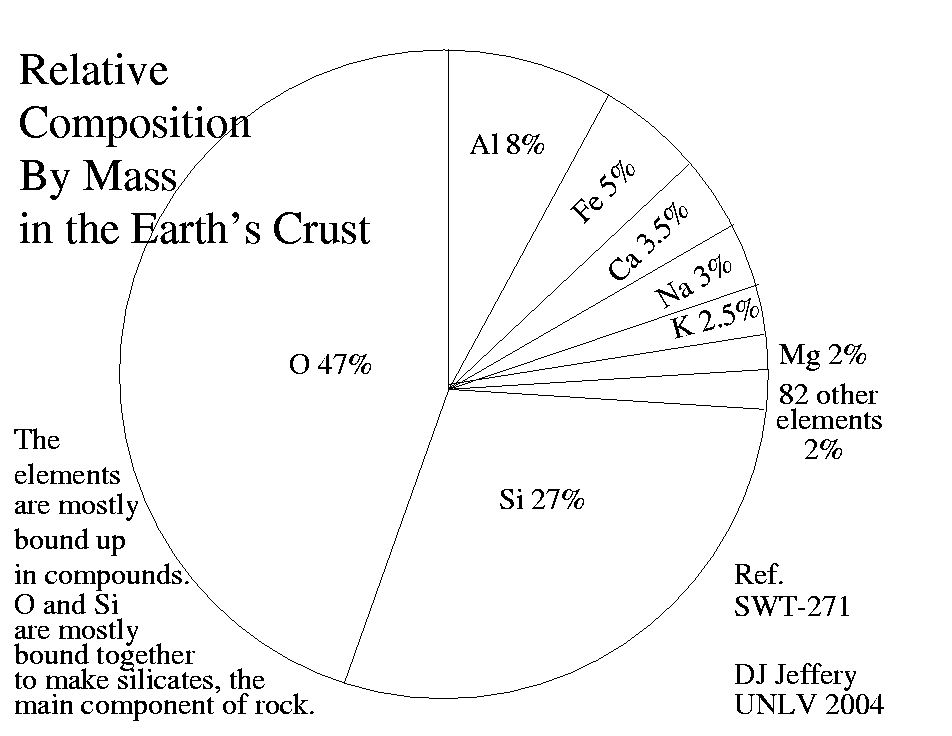
Caption: The Earth crust composition (elemental composition) by mass fraction shown in a pie chart.
Features:
- The values for the elemental
chemical compound compositions of the
Earth's crust
vary with reference and time (since on
online references get updated).
So the values given in the pie chart and tables below are good representative values, but NOT timeless truth.
Note, the values in the pie chart and the first table don't agree with each other exactly.
- The
average density
of the upper crust is estimated to be in the range 2.69--2.74 g/cm**3
of the lower crust is estimated to be in the range 3.0--3.25 g/cm**3
(see Wikipedia: Earth Crust: Composition).
- The elemental composition is shown in the
following table:
Table: Earth Crust Elemental Composition by Mass Fraction Ordered by Abundance:
- Element, Mass Fraction.
- oxygen (O, Z=8), 46.6 %.
- silicon (Si, Z=14), 27.7 %.
- aluminum (Al, Z=13), 8.1 %.
- iron (Fe, Z=26), 5.0 %.
- calcium (Ca, Z=20), 3.6 %.
- sodium (Na, Z=11), 2.8 %.
- potassium (K, Z=19), 2.6 %.
- magnesium (Mg, Z=12), 1.5 %.
- everything else (i.e., remainder, 2.1 %.
- Reference: Wikipedia: Earth Crust: Composition.
- Note that due to atmospheric escape
in the
Solar System formation
(4.6 Gyr BP)) era,
the Earth is depleted in
volatiles
(most obviously
hydrogen (H)
and helium (He))
relative to the
primordial solar nebula composition.
Chemical differentiation
in the era of the
formation of the Earth
4.54(5) Gyr ago
(see Wikipedia: Age of the Earth)
caused the denser
elements
(most notably
iron (Fe) and
nickel (Ni)) to preferential sink
to the
Earth's interior leaving the
Earth's crust
to be depleted in these
elements
relative to the
primordial solar nebula composition.
For the primordial solar nebula composition see file solar_composition.html.
- Overwhelmingly most
matter in the
Earth's crust is
NOT in the form of
chemically pure elements.
It is in the form of chemical compounds of which there are a vast number mostly in form of crystals.
Most of this matter is also classifiable as rock and most of the rock is silicate (a kind of silicon compound) containing oxygen. That this so is very plausible based on the table above where oxygen and silicon are shown as the most abundant elements and they certainly are NOT in pure form in the Earth's crust. Silicate is often virtually a synonym for rock.
Note some rock is NOT in form of crystals, but in the form of amorphous solids.
- Below we give a table showing
chemical compound composition of
the Earth's crust.
Table: Earth Crust Chemical Compound Composition by Mass Fraction Ordered by Abundance:
- Chemical Compound, Mass Fraction.
- SO2 (silica) mostly as quartz, 60.6 %.
- Al2O3 (corumdum), 15.9 %.
- FeO (iron(II) oxide, ferrous oxide), 6.7 %. It's NOT rust which is several other kinds of iron oxide.
- CaO (calcium oxide, quicklime), 6.4 %.
- MgO (magnesium oxide, magnesia), 4.7 %.
- Na2O (sodium oxide), 3.1 %.
- K2O (potassium oxide), 1.8 %.
- TiO2 (titanium dioxide), 0.7 %.
- P2O5 (phosphorous pentoxide), 0.1 %.
- everything else NOT water (i.e., remainder), << 1 %. The abundances have been scaled (to exclude water) and rounded to add up to 100 %.
- Reference: Wikipedia: Earth Crust: Composition.
- Water (H2O) is excluded from the chemical compound list. There is a lot of water in the Earth's crust (see Wikipedia: Water distribution on Earth).
- Note oxygen occurs in all the chemical compounds listed. This is because oxygen is very abundant in the Earth's crust (see Table: Earth Crust Elemental Composition by Mass Fraction Ordered by Abundance) and very reactive chemically. Recall molecular oxygen (O2) is the key substance for respiration and ordinary combustion.
Image link: Itself.
File: Earth file: earth_crust_composition.html.